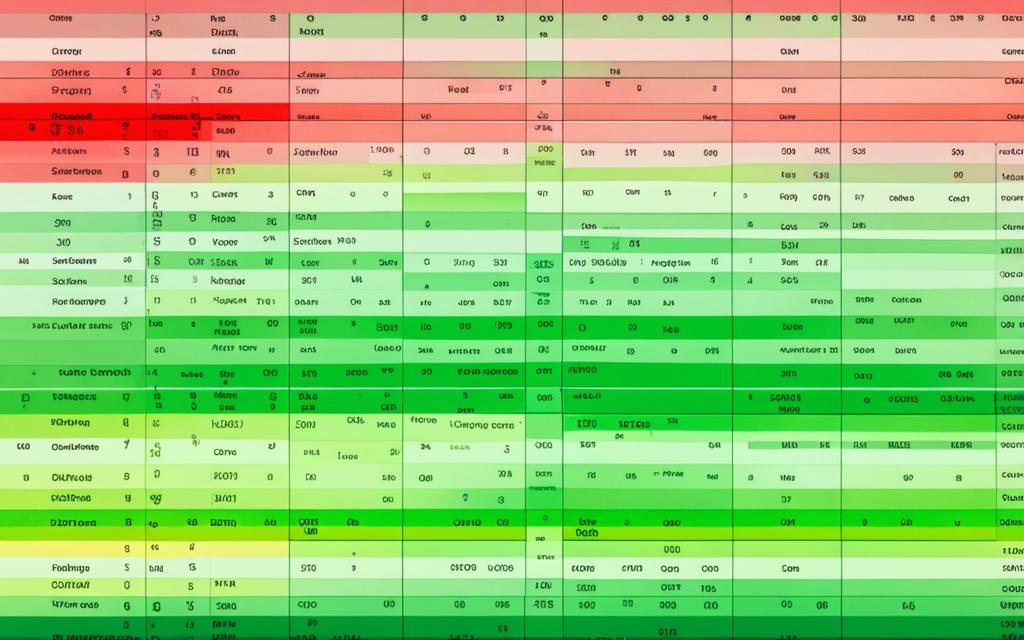Table of Contents
It’s vital to keep CPUs within safe operating temperatures, for this affects both their speed and lifespan. A healthy CPU temperature is roughly between 30°C (86°F) to 40°C (104°F) when not doing much, when CPU use is low1. When the CPU works harder, temperatures typically are between 60°C to 70°C (140°F to 158°F), which is considered normal1.
But, it’s important to watch out if the temperature goes over 80°C (176°F). High heat for too long can harm the CPU’s performance and may cause damage21. By knowing these temperature ranges, you can choose the right cooling solutions. This helps keep your CPU working at its best for longer.
Key Takeaways
- The normal idle temperature range for most CPUs is 30°C to 40°C.
- Under load, CPUs typically operate within 60°C to 70°C.
- Exceeding 80°C can lead to performance issues and long-term damage.
- Monitoring CPU temperature is crucial for maintaining performance and longevity.
- Understanding CPU temperature ranges helps in selecting suitable cooling solutions.
Understanding CPU Temperature
Learning about CPU temperature basics is crucial for anyone wanting to keep their processor in good shape. As the CPU works, it gets hot. This heat needs to be handled well to keep the CPU running smoothly and last longer. When not doing much, CPU temperatures usually are between 30°C (86°F) and 40°C (104°F)1. When working hard, they often reach 60°C to 70°C (140°F to 158°F)1. It’s generally safe for the CPU to work up to 80°C (176°F), but going higher can shorten its life1.
Keeping an eye on CPU temperatures is key, especially when it’s working hard. Then, temperatures can jump to between 70°C and 80°C (158°F to 176°F)3. If it gets to 80-85°C (176–185°F) or more, this might mean there’s a problem3. Staying within a cooler 45-60°C (113-140°F) when not much is happening helps manage the heat better. This avoids overheating and damage3. To keep things cool, keeping components clean and ensuring air moves well around them is key4.
What Is a Safe Temp for a CPU
Knowing the right temperature for your CPU is key for good performance and a long life. When not much is happening, a CPU’s temperature is usually between 30°C and 40°C (86°F to 104°F). Under heavy use, like when gaming or editing videos, it can go up to about 70°C to 80°C (158°F to 176°F)5.
Normal Temperature Ranges
Under normal use, a PC’s CPU temperature stays between 40°C to 60°C. With intensive tasks, it might jump to about 80°C5. Important to know, modern CPUs slow down if they get too hot. This helps avoid damage by lowering the speed if it gets too warm5.
Critical Temperature Points
If CPU temperatures go above 90°C (194°F), it’s worrying. Staying so hot can seriously harm your CPU56. A temperature over 100°C means there’s a big problem and cooling is needed. Some older CPUs might stand hotter temperatures, but 97°C at rest suggests a cooling issue5.
To keep things stable, keep the throttle temperature under 85°C6. CPUs work best within specific temperature limits. It’s suggested not to let them get hotter than 70°C to 80°C when busy. Staying too hot for too long hurts their performance and life5.
The Importance of Monitoring CPU Temperature
Keeping an eye on CPU temperature is key for top performance and hardware life. For gamers, the perfect running temperature is between 60-85°C. This helps stop the CPU from getting too hot. Regularly checking the CPU temperature spots overheating early on. This way, it avoids thermal overheating prevention slowdowns, which can start at 85°C7.
If the CPU gets too hot, it could harm the inside parts. It’s important to know the safe temperature range. When not in use, the CPU should stay between 30-40°C. While doing simple tasks, it should read 40-60°C7. During heavy use, like editing videos, temperatures can reach 70-95°C. This shows why it’s crucial to keep track and have good cooling8.
To better handle heat, several steps are needed. This includes better cooling, adding new thermal paste, and cleaning out dust. HWiNFO is a tool that helps track both CPU and GPU temperatures over time. It’s a great help for keeping an eye on things8.
Putting in the effort to avoid overheating makes sure your system runs well and lasts longer. Acting before overheating happens can cut down on system crashes and unexpected shut-offs8. Getting the right cooling tech, like extra fans or liquid cooling, boosts performance too.
| CPU Temperature State | Temperature Range (°C) | Action Required |
|---|---|---|
| Idle | 30-40 | No action required |
| Light Load | 40-60 | Monitor regularly |
| Normal (intensive tasks) | 70-95 | Ensure cooling efficiency |
| Critical (overheating) | Above 95 | Immediate intervention needed |
Focusing on CPU temperature monitoring enhances system efficiency and reliability. A proactive approach lead to a better computing experience. It keeps the system clean and the hardware in good shape9.
How to Check CPU Temperature
Knowing the correct way to check your CPU’s temperature is vital. It helps keep your computer running well and stops it from getting too hot. You can look at the BIOS settings or use tools made by others to do this.
Using BIOS for Temperature Readings
Getting into the BIOS is an easy way to check your CPU’s heat. You just restart your computer and hit a key during startup to enter BIOS. Once there, you can see the temperature right away. This method doesn’t show the highest temperature it reaches, but it’s useful. It’s good to check this to make sure the temperature stays below 60°C for the best performance10.
Third-Party Software Tools
Many CPU monitoring software tools are available for keeping an eye on temperature. Well-liked choices include Core Temp, HWMonitor, and NZXT CAM. These tools give detailed info on your CPU’s heat, but they might use a bit of CPU power. For those who do a lot of gaming or use heavy programs, keeping temperatures between 70° and 85°C is crucial1011.
Factors Affecting CPU Temperature
It’s vital to know what affects CPU temperature for the best performance and long life. The heat it generates depends on the task at hand. High-demand tasks like games or video editing make it hotter. Keeping the CPU cool, ideally under 60 degrees C, avoids shutdowns and keeps it working well12.
Workload and Usage Patterns
What you do on your computer directly impacts its temperature. Gaming can push your CPU’s heat between 65 and 85 degrees C. Such heat over time can harm your computer12. Ideally, your CPU should stay cool around 45-50 degrees C when not busy. With tougher tasks, it may reach up to 80-90 degrees C13. Knowing this, you can manage how you use your device to prevent overheating.
Cooling Solutions and Case Ventilation
Keeping your CPU cool requires good cooling strategies and ensuring the case is well-ventilated. Dust can clog up and overheat your system12. Clean the insides every few months to prevent this14. Good thermal paste and extra fans boost cooling. If it gets too hot, your CPU might slow down to avoid damage14.
Signs Your CPU Is Overheating
Knowing when your computer is overheating is vital. It keeps your computer healthy and performing well. One sign is performance degradation. This includes lagging, freezing, and crashes. When your CPU gets too hot, these CPU overheating symptoms can ruin your computing experience. Seeing these signs early lets you fix cooling issues quickly.
Performance Issues
An overheating CPU causes big problems. For example, it may shut down automatically at temperatures between 70°C and 100°C15. Such shutdowns can interrupt your work and cause data loss. Overheating leads to errors in your programs. It’s important to notice these signs early.
Visual Indicators and Alerts
Watching for visual signs is also key. Monitoring software can alert you if your CPU gets too hot. Keep an eye out for errors and warnings about high CPU temperatures. Signs like noisy fans or a warmer room suggest it’s time for action. Visit this site to learn how to check CPU temperatures. Paying attention to these overheating signs helps prevent damage and keeps your system running smoothly.
Regular cleaning of dust from vents and fans helps avoid overheating15. Using tools like Core Temp and accessing your BIOS can also protect your computer16.
FAQ
What is the normal temperature range for a CPU?
The usual idle temperature range for CPUs is between 30°C and 40°C. Under intense tasks like gaming, it rises to 60°C to 80°C.
Why is it important to monitor CPU temperature?
Checking your CPU’s temperature is key to avoid overheating. Overheating harms performance and may damage your processor. Regular monitoring is a smart way to spot problems early, keeping your CPU in good shape.
How can I check the temperature of my CPU?
To check your CPU temperature, you can look at the BIOS when your computer starts. Or, use software like Core Temp for up-to-date data with minimal system load.
What are the signs that my CPU might be overheating?
Overheating CPUs may lag, crash, or become less responsive. Alert messages from software might also pop up. Spotting these signs early is crucial to proper cooling.
What are the critical temperature thresholds for CPUs?
CPUs face risks exceeding 80°C regularly. Try to keep the temperature below 90°C for your processor’s health and performance.
What factors can affect CPU temperature?
Many elements influence CPU heat, including how much you use it and your cooling system’s efficiency. Clean, well-ventilated cases keep temperatures lower.
How do cooling solutions impact CPU performance?
Good cooling and airflow prevent your CPU from getting too hot. Thermal paste and heatsinks play a big role in this. They help your CPU work better.
What should I do if my CPU temperature exceeds safe limits?
If your CPU gets too hot, improve cooling with better airflow or cleaning. Adding fans or a new heatsink might also help. It’s all about keeping your CPU cool for it to work well.
Source Links
- https://www.noyafa.com/blogs/knowledge-base/good-cpu-temperature – What Is A Good CPU Temperature? A Guide to Keep Your Processor Cool
- https://www.buildcomputers.net/cpu-temperature.html – CPU Temperature – What are the Normal and Maximum CPU Temps?
- https://www.avast.com/c-how-to-check-cpu-temperature – How to Check and Monitor Your CPU Temperature
- https://www.tomshardware.com/how-to/how-to-check-cpu-temp-temperature – How to Check Your CPU Temperature
- https://community.spiceworks.com/t/what-is-a-normal-temperature-for-a-cpu-and-how-do-i-keep-it-low/948818 – What is a normal temperature for a CPU and how do I keep it low?
- https://forums.tomshardware.com/threads/is-my-cpu-temperature-safe.3725283/ – [SOLVED] – Is my cpu temperature safe?
- https://computercity.com/hardware/processors/normal-cpu-temperatures – Normal CPU Temperatures: Guidelines for Safe & Optimal Performance – ComputerCity
- https://koolingmonster.com/insights/how-to-check-cpu-temperature-and-why-is-it-important – How to Check CPU Temperature and Why Is It Important? — Kooling Monster
- https://www.lenovo.com/us/en/glossary/what-is-cpu-temperature/ – Cpu Temperature: What is CPU Temperature?
- https://www.pandasecurity.com/en/mediacenter/how-to-check-cpu-temp/ – How to Check Your CPU Temperature – Panda Security
- https://www.avg.com/en/signal/check-cpu-temperature – How to Check and Monitor CPU Temperature on Windows and Mac
- https://www.makeuseof.com/tag/pc-operating-temperatures-hot-hot/ – PC Operating Temperatures: How Hot Is Too Hot?
- https://www.computerhope.com/issues/ch000687.htm – What Should Be the Temperature of My Computer Processor?
- https://www.diskmfr.com/importance-of-cpu-temperature-range-signs-and-solutions/ – Importance of CPU Temperature: Range, Signs, and Solutions
- https://techvilleonline.com/is-your-computer-overheating-6-signs-it-is-and-how-to-fix-it/ – Is Your Computer Overheating?: 6 Signs It is And How to Fix It
- https://www.drivereasy.com/knowledge/how-to-know-your-cpu-overheating-and-fix-prevent-it/ – How to Know Your CPU Overheating and How to Fix It – Driver Easy








